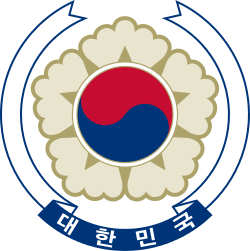Coup d'état of May Seventeenth
Part of a series on the |
||||||||||||||||||||||||||||||||||||||||||||||||||||||||||||||||||
|---|---|---|---|---|---|---|---|---|---|---|---|---|---|---|---|---|---|---|---|---|---|---|---|---|---|---|---|---|---|---|---|---|---|---|---|---|---|---|---|---|---|---|---|---|---|---|---|---|---|---|---|---|---|---|---|---|---|---|---|---|---|---|---|---|---|---|
| History of South Korea | ||||||||||||||||||||||||||||||||||||||||||||||||||||||||||||||||||
 | ||||||||||||||||||||||||||||||||||||||||||||||||||||||||||||||||||
|
||||||||||||||||||||||||||||||||||||||||||||||||||||||||||||||||||
|
| ||||||||||||||||||||||||||||||||||||||||||||||||||||||||||||||||||
Coup d'état of May Seventeenth was a military coup d'état carried out in South Korea by general Chun Doo-hwan and Hanahoe that followed the Coup d'état of December Twelfth.
On May 17, 1980, General Chun Doo-hwan forced the Cabinet to extend martial law to the whole nation, which had previously not applied to Jeju-do. The expanded martial law closed universities, banned political activities and further curtailed the press. To enforce the martial law, troops were dispatched to various parts of the nation. On the same day, KCIA raided a national conference of student union leaders from 55 universities.[1] About 2700 people including twenty-six politicians were also arrested.[2] On May 18, 1980, Citizens of Gwangju rose up against Chun Doo-hwan's military dictatorship and took control of the city. In the course of the uprising, citizens took up arms to defend themselves, but were ultimately crushed by the South Korean army.(Gwangju Democratic Uprising)
In May 20, 1980, Chun Doo-hwan and Roh Tae-woo ordered the National Assembly to be dissolved by deploying troops in the National Assembly. Chun subsequently created the National Defense Emergency Policy Committee, and installed himself as a member. On 17 July, he resigned his position of KCIA Director, and then held only the position of committee member. In September 1980, President Choi Kyu-ha was forced to resign from president to give way to the new military leader, Chun Doo-hwan.[3]
References
- ↑ May, The Triumph of Democracy. Ed. Shin Bok-jin, Hwang Chong-gun, Kim Jun-tae, Na Kyung-taek, Kim Nyung-man, Ko Myung-jin. Gwangju: May 18 Memorial Foundation, 2004.
- ↑ 12.12, 5.18및 비자금사건 논고문
- ↑ 5·18 내란 사건 대법원 판결문 요지